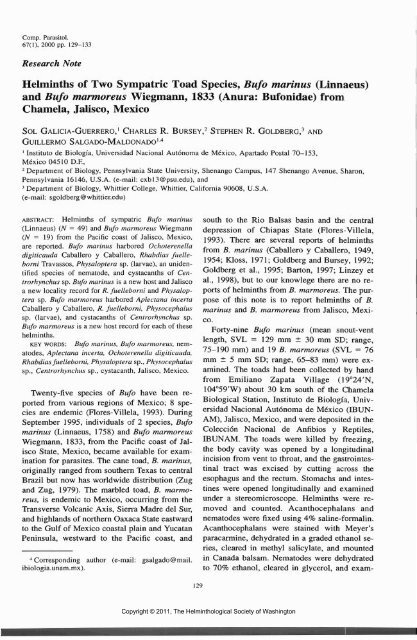Comparative Parasitology 67(1) 2000 - Peru State College
Comparative Parasitology 67(1) 2000 - Peru State College
Comparative Parasitology 67(1) 2000 - Peru State College
You also want an ePaper? Increase the reach of your titles
YUMPU automatically turns print PDFs into web optimized ePapers that Google loves.
Comp. Parasitol.<br />
<strong>67</strong>(1), <strong>2000</strong> pp. 129-133<br />
Research Note<br />
Helminths of Two Sympatric Toad Species, Bufo marinus (Linnaeus)<br />
and Bufo marmoreus Wiegmann, 1833 (Anura: Bufonidae) from<br />
Chamela, Jalisco, Mexico<br />
SOL GALICIA-GUERRERO,1 CHARLES R. BURSEY,2 STEPHEN R. GOLDBERG,3 AND<br />
GUILLERMO SALGADO-MALDONADO1'4<br />
1 Institute de Biologfa, Universidad Nacional Autonoma de Mexico, Apartado Postal 70-153,<br />
Mexico 04510 D.F.,<br />
2 Department of Biology, Pennsylvania <strong>State</strong> University, Shenango Campus, 147 Shenango Avenue, Sharon,<br />
Pennsylvania 16146, U.S.A. (e-mail: cxbl3@psu.edu), and<br />
1 Department of Biology, Whittier <strong>College</strong>, Whittier, California 90608, U.S.A.<br />
(e-mail: sgoldberg@whittier.edu)<br />
ABSTRACT: Helminths of sympatric Bufo marinus<br />
(Linnaeus) (N = 49) and Bufo marmoreus Wiegmann<br />
(TV = 19) from the Pacific coast of Jalisco, Mexico,<br />
are reported. Bufo marinus harbored Ochoterenella<br />
digiticauda Caballero y Caballero, Rhabdias fuelleborni<br />
Travassos, Physaloptera sp. (larvae), an unidentified<br />
species of nematode, and cystacanths of Centrorhynchus<br />
sp. Bufo marinus is a new host and Jalisco<br />
a new locality record for R. fuelleborni and Physaloptera<br />
sp. Bufo marmoreus harbored Aplectana incerta<br />
Caballero y Caballero, R. fuelleborni, Physocephalus<br />
sp. (larvae), and cystacanths of Centrorhynchus sp.<br />
Bufo marmoreus is a new host record for each of these<br />
helminths.<br />
KEY WORDS: Bufo marinus, Bufo marmoreus, nematodes,<br />
Aplectana incerta, Ochoterenella digiticauda,<br />
Rhabdias fuelleborni, Physaloptera sp., Physocephalus<br />
sp., Centrorhynchus sp., cystacanth, Jalisco, Mexico.<br />
Twenty-five species of Bufo have been reported<br />
from various regions of Mexico; 8 species<br />
are endemic (Flores-Villela, 1993). During<br />
September 1995, individuals of 2 species, Bufo<br />
marinus (Linnaeus, 1758) and Bufo marmoreus<br />
Wiegmann, 1833, from the Pacific coast of Jalisco<br />
<strong>State</strong>, Mexico, became available for examination<br />
for parasites. The cane toad, B. marinus,<br />
originally ranged from southern Texas to central<br />
Brazil but now has worldwide distribution (Zug<br />
and Zug, 1979). The marbled toad, B. marmoreus,<br />
is endemic to Mexico, occurring from the<br />
Transverse Volcanic Axis, Sierra Madre del Sur,<br />
and highlands of northern Oaxaca <strong>State</strong> eastward<br />
to the Gulf of Mexico coastal plain and Yucatan<br />
Peninsula, westward to the Pacific coast, and<br />
4 Corresponding author (e-mail:<br />
ibiologia.unam.mx).<br />
gsalgado@mail.<br />
129<br />
south to the Rio Balsas basin and the; central<br />
depression of Chiapas <strong>State</strong> (Flores-Villela,<br />
1993). There are several reports of helminths<br />
from B. marinus (Caballero y Caballero, 1949,<br />
1954; Kloss, 1971; Goldberg and Bursey, 1992;<br />
Goldberg et al., 1995; Barton, 1997; Linzey et<br />
al., 1998), but to our knowlege there are no reports<br />
of helminths from B. marmoreus. The purpose<br />
of this note is to report helminths of B.<br />
marinus and B. marmoreus from Jalisco, Mexico.<br />
Forty-nine Bufo marinus (mean snout-vent<br />
length, SVL = 129 mm ± 30 mm SD; range,<br />
75-190 mm) and 19 B. marmoreus (SVL = 76<br />
mm ± 5 mm SD; range, 65-83 mm) were examined.<br />
The toads had been collected by hand<br />
from Emiliano Zapata Village (19°24'N,<br />
104°59'W) about 30 km south of the Chamela<br />
Biological Station, Institute de Biologfa, Universidad<br />
Nacional Autonoma de Mexico (IB UN-<br />
AM), Jalisco, Mexico, and were deposited in the<br />
Coleccion Nacional de Anfibios y Reptiles,<br />
IBUNAM. The toads were killed by freezing,<br />
the body cavity was opened by a longitudinal<br />
incision from vent to throat, and the gastrointestinal<br />
tract was excised by cutting across the<br />
esophagus and the rectum. Stomachs and intestines<br />
were opened longitudinally and examined<br />
under a stereomicroscope. Helminths were removed<br />
and counted. Acanthocephalans and<br />
nematodes were fixed using 4% saline-formalin.<br />
Acanthocephalans were stained with Meyer's<br />
paracarmine, dehydrated in a graded ethanol series,<br />
cleared in methyl salicylate, and mounted<br />
in Canada balsam. Nematodes were dehydrated<br />
to 70% ethanol, cleared in glycerol, and exam-<br />
Copyright © 2011, The Helminthological Society of Washington
















